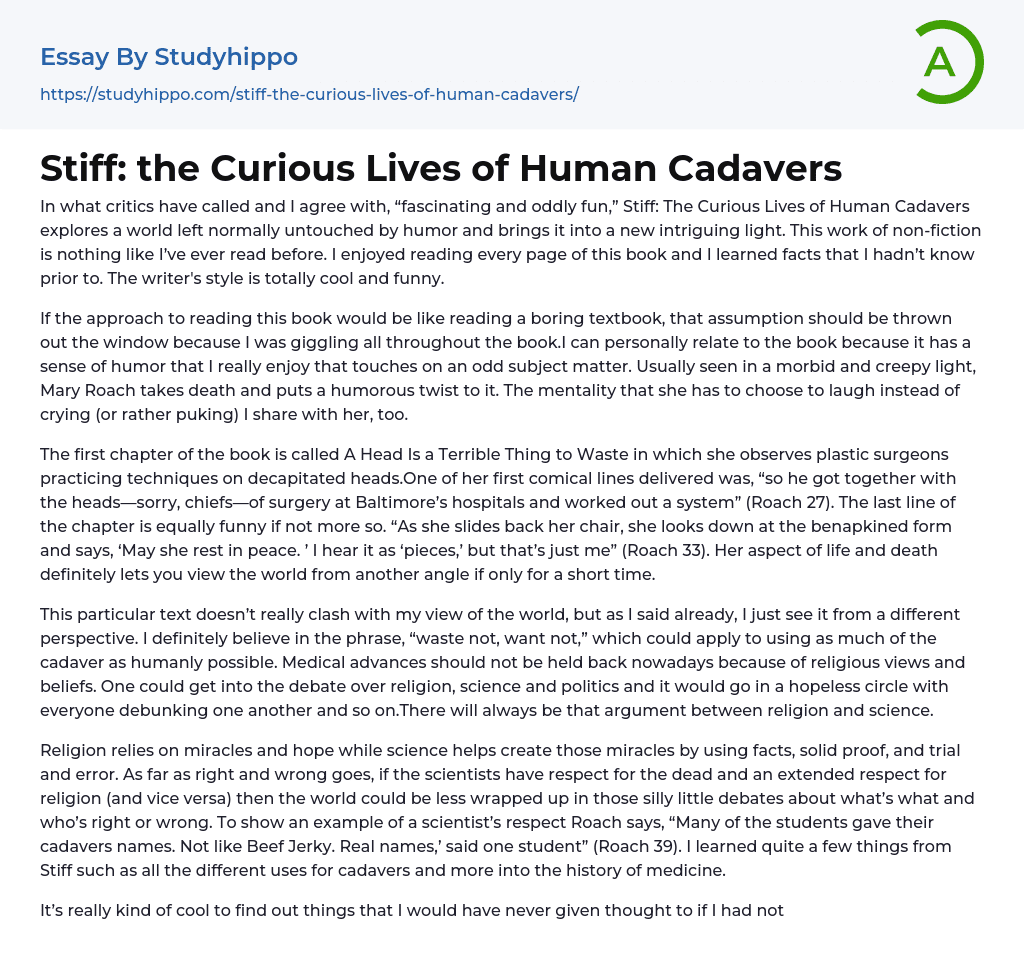"Stiff: The Curious Lives of Human Cadavers" is an exceptional non-fiction work that offers a captivating and distinctive portrayal of an ordinarily serious topic. It differs from my other readings, as it provides both amusement and insight at each juncture. Furthermore, the writer's clever tone combined with their composed writing style enhances the book's distinctiveness.
Even though this book could have been boring like a textbook, it kept me laughing continuously with its humor. Mary Roach handles the subject matter, which can be disturbing and creepy, in an amusing way that I personally find appealing. Her unconventional perspective on death adds a comic touch to it, as she chooses to see the funny side of unsettling situations instead of giving in to hopelessness or disgust.
The initial chapter of the book, named A Head Is a Terri
...ble Thing to Waste, recounts the author's observations of plastic surgeons performing procedures on severed heads. One of her amusing lines is, "so he got together with the heads—sorry, chiefs—of surgery at Baltimore’s hospitals and worked out a system" (Roach 27). The final sentence of the chapter is equally witty, if not more so. "As she slides back her chair, she looks down at the benapkined form and says, ‘May she rest in peace.’ I hear it as ‘pieces,’ but that’s just me" (Roach 33). Her perspective on life and death undoubtedly provides a distinct vantage point if only for a brief period.
Although my perspective differs, this text does not contradict my worldview. I firmly support the notion of utilizing every aspect of a cadaver and adhering to the principle of "waste not, want not." Modern medical advancements should no
be hindered by religious ideologies. The debate between religion, science, and politics seems to be a perpetual cycle where each side attempts to discredit the other. The tension between religion and science will likely persist indefinitely.
Religion and science have distinct characteristics - the former depends on miracles and hope, while the latter employs facts, concrete evidence, and experimental testing to create its own miracles. Respecting the dead and religion is a crucial factor in bridging the gap between these two fields. With mutual understanding, society can avoid pointless arguments about right and wrong. As an illustration of scientific reverence, Roach stated, "Many of the students gave their cadavers names. Not like Beef Jerky. Real names,' said one student" (Roach 39). From Stiff, I've acquired knowledge about the varied applications of cadavers and a deeper understanding of the history of medicine.
After reading Stiff, I gained an appreciation for learning new and unique information. The book provided inventive ways of expressing common phrases with a more intellectual tone, such as the example "Others must feel the same; there isn't an anhydrous lacrimal gland in the house" (Roach 38) to mean "there wasn't a dry eye in the house". Alongside the captivating insights into the history of anatomy and behind-the-scenes of medicine, Stiff also presents unsettling and potentially disturbing information. While the book is intriguing, it can be overwhelming with information overload at times.
Upon finishing Stiff, I engaged in introspection regarding my mortality, beliefs, and posthumous desires. While the content was occasionally overwhelming, I recognized that my response to the book might differ if I had recently experienced the loss of a loved one due to illness, surgery
or accident. It became clear that certain segments of the book were meant to be solemn since life is not solely humorous. The autopsy procedure emphasizes body parts rather than the person as a whole, with depictions beginning at the eyes and progressing towards the mouth.
Roach (116-117) suggests that the most effective way to engage with others on an emotional level is by avoiding making judgments based on their personal situations. In my perspective, I found this book to be thoroughly enjoyable and compelling, sparking my curiosity in seeking out similar literature in the future.
Mary Roach's book, "Stiff: The Curious Lives of Human Cadavers," is best suited for readers who share the author's humorous approach to death, similar to her father. Although it provides valuable information on the physical aspects of death, some chapters contain graphic descriptions that may not be suitable for all readers and could require a certain level of emotional detachment.
- Age Of Enlightenment essays
- Ethos essays
- Time essays
- Acceptance essays
- Meaning Of Life essays
- Reality essays
- Natural Law essays
- Political Philosophy essays
- Utilitarianism essays
- Existence essays
- Free Will essays
- Good And Evil essays
- Confucianism essays
- Relativism essays
- Conscience essays
- Environmentalism essays
- Empiricism essays
- Epistemology essays
- Ethics essays
- Existentialism essays
- Human Nature essays
- Individualism essays
- Metaphysics essays
- Philosophy Of Life essays
- Transcendentalism essays
- Truth essays
- Destiny essays
- Determinism essays
- Fate essays
- Functionalism essays
- Philosophers essays
- Pragmatism essays
- Future essays
- Child Observation essays
- Critical Reflection essays
- Teaching Philosophy essays
- Personal Philosophy essays
- Action Speak Louder Than Words essays
- Can Money Buy Happiness essays
- Values of Life essays
- Ethical dilemma essays
- Normative Ethics essays
- Virtue Ethics essays
- Belief essays
- Deontology essays
- Moral essays
- Virtue essays
- Work Ethic essays
- Henry David Thoreau essays
- Carl Jung essays




